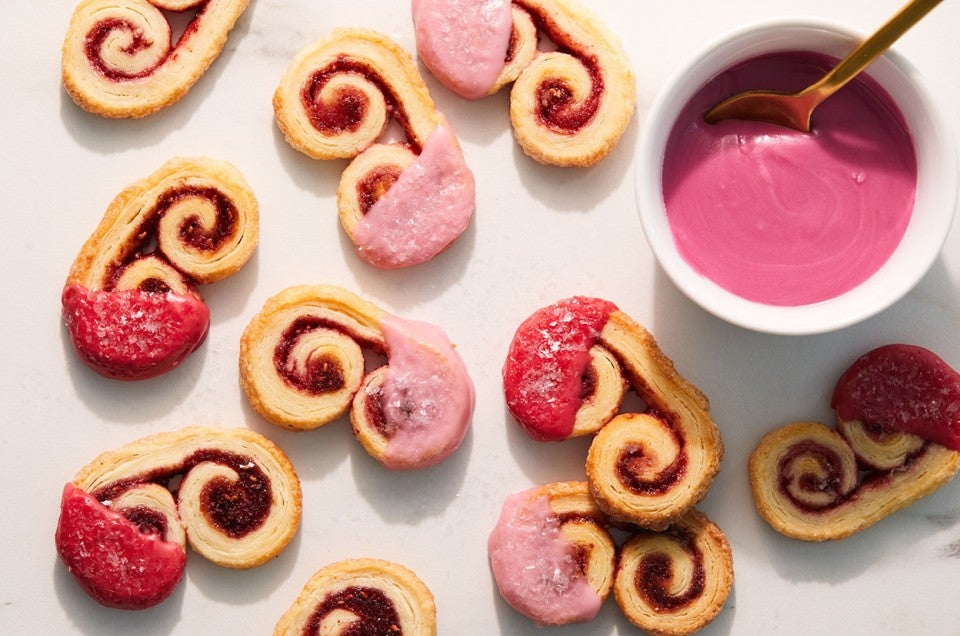How to bake with the freeze-dried fruit powders you're seeing everywhere
Fruity flavor and captivating color with one simple ingredient.


We're excited to welcome cookbook author Hetal Vasavada of Milk & Cardamom back to the King Arthur blog. Below, she shares how to use freeze-dried fruit to take your baking to a new colorful dimension.
* * *
In the past year, you may have seen swirls of
You can find a variety of freeze-dried fruits in powdered form or whole, and they’re available in a multitude of flavors including blueberry, strawberry, mango, peach, apple, and more. Curious about how to use them to add flavor and color to your baking? Read on.

If you’ve ever had astronaut ice cream, you’ve had freeze-dried food before. Freeze-drying is a dehydration process in which all the moisture in food is driven off using freezing temperatures and low pressure. The water in fruit sublimates (meaning it goes directly from ice to water vapor without going through a liquid phase), allowing the fruit to be preserved for long periods of time. This process also concentrates the fruit flavor and gives the fruit a distinctly dry, brittle texture.
You can typically find sliced freeze-dried fruit at your grocery store, often sold as tasty snacks. And indeed, it’s tart, sweet, and crunchy, making it delicious to eat on its own. But skip the snacking and save the fruit for baking, and you’ll find it has a whole variety of uses.

Freeze-dried fruit is typically ground into a powder when used in baking. You can use a food processor or spice grinder to easily transform it into a super-fine powder, but a mortar and pestle also works well to create a coarser powder. These coarse powders are great to use as decoration or to add a speckled look to cookies (almost like sprinkles!).
The uses for fine freeze-dried fruit powder are truly endless: It can be mixed into batters, icings, doughs, and more. These powders add a tanginess and punch to your desserts that makes them ideal for rich treats like chocolate truffles, thick buttercream frosting, buttery shortbread, and deep-fried desserts like doughnuts and churros. The amount you add is truly up to you and how much flavor you want to infuse into your dessert — here are my guidelines on how much to add for some common baked goods:
For bright colors, use color-rich fruits like blueberries, strawberries, raspberries, or cherries. Keep in mind that fruits such as apples, peaches, and mangoes have very little color, as they lose much of their color during the freeze-drying process; that said, they still offer a nice boost of flavor. Beyond the fruity flavor freeze-dried fruits impart, they also add a bit of tanginess to your dish. The citric acid in the fruit gets concentrated during the freeze-drying process, giving it a faint sourness.

One of my favorite ways to bake with freeze-dried fruit is by making colorful, fruity confectioners' sugar. I like to use 2 parts freeze-dried fruit to 1 part confectioners' sugar by weight. (Confectioners' sugar contains cornstarch, which helps prevent the freeze-dried fruit powder from clumping once blended.) Combine the two ingredients together in a food processor or a high-speed blender until fine, then sift the mixture into a container.
This confectioners' sugar mixture can be used as a substitute for confectioners' sugar in any recipe. Personally, I like to roll cookies like Wedding Cookies or pecan fingers in the colorful sugar once they’ve cooled for an extra-decorative and flavorful touch; chocolate truffles or cake truffles are also great to use. Of course, you can dust it over desserts like marshmallows, lemon bars, and doughnuts, or add to icing as a natural food coloring.


Us bakers are all about homemade, so you may be curious about freeze-drying your own fruit. And you can, using dry ice.
You'll need to use equal parts of fruit and dry ice by weight. You want to use high-moisture fruit like strawberries, watermelon, oranges, grapes, or berries. Prep fruit like oranges and watermelon by peeling and cutting them (peel citrus and break into segments; slice pears or apples 1/4" thick); grapes and berries can be left whole.
Place the fruit in a freezer-safe storage bag, then add to a cooler or insulated box and cover the fruit directly with dry ice. Don't seal the container, as expanding gases can cause the container to explode; if you have a lid, place it loosely on top.
Let it sit until the dry ice has completely evaporated off; this can take anywhere from 24 to 48 hours. The fruit will be freeze-dried at this point. Place the dried fruit in a dry, air-tight container and store at room temperature.
Store-bought or homemade, the life span of freeze-dried fruit starts to diminish after it’s exposed to air. The fruit starts to pull moisture from the air and will eventually turn gummy, chewy, and sticky if not stored properly, so be sure to store any freeze-dried fruit in an airtight container in a cool space.
One of my tricks is to save the desiccator packs in seaweed snacks (the little white packet filled with clear beads meant to pull moisture away from food to keep it crisp) and place them in the container to make sure no moisture reaches my fruit and it stays nice and dry.
To add more color to your baking with natural ingredients, see this previous post on how to make natural food coloring.
Cover photo of Mini Raspberry Palmiers by Erica Allen.

